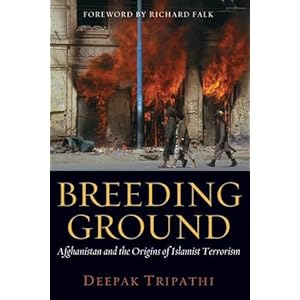Live Q&A with Deepak Tripathi

You've worked in Afghanistan and Pakistan as a BBC correspondent. How does the Afghanistan of today compare to the pre-civil war Afghanistan of 1978?
Before the 1978 communist coup which triggered the war, Afghanistan was fairly quiet and, especially for foreign visitors, very safe. People were hospitable. It was a desperately poor country, but people went about their day-to-day living. The king had been overthrown by his cousin, but Afghanistan was in practice ruled by the royals.
So what happened? Did the Soviet invasion cause the subsequent thirty-odd years of unrest, or did it uncork simmering problems in Afghan society?
In broad terms, internal disturbance began with the overthrow of the king by his cousin, who was a modernizer and didn't like the king's noninterventionist approach. His coup began internal feuds among factions.
Young relatively educated communists were among them. But the 1978 coup by pro-Soviet army officers seized power in 1978, triggered internal strife and greater Soviet intervention. It was to save the communist regime that was deeply unpopular and collapsing that the Soviets invaded Afghanistan in December 1979.
Where does Islamist ideology enter the picture?
I said earlier that there were factions during the king's cousin, Mohammad Daud's rule from 1973 to 1978. His vigorous drive for modernization brought Islamist groups to the fore to oppose him.
But we must always remember, Afghanistan is a deeply religious country, although historically Afghan society was heavily influenced by the most liberal of the Muslim sects, the Hanafi sect. However, with conflict escalating moderation declined.
Tell us a bit about the Hanafi sect—I've never heard of them before.
The Hanafi sect is based on local practical considerations to find resolutions to local problems. Hanafis have tended to favor social harmony. It was because of this moderation that followers of other religions—Hindus, Buddhists in particular, lived in peace. Hindu merchants in Kabul, a tiny minority, were quite powerful. When I was in Afghanistan in the early 1990s, I went to Afghan Hindu money changers. However, with the Soviet invasion and American help to mujahideen groups, which incidentally began under the Carter administration in mid-1979, and then under the Regan administration from January 1981, Arab fighters began to arrive to confront the Soviet occupation forces, the nature of Afghan society began to change dramatically and violently.
Why did the Soviets make the decision to invade? More specifically, who within the Soviet government was an advocate of invasion and who was opposed?
I explain in my book Breeding Ground the long sequence of events. In brief, there is evidence available that the Soviets were deeply unhappy with factionalism in Afghanistan's communist regime, which is to say the government after the 1978 coup. And the Afghan communist regime's brutal suppression of opposition made it increasingly unpopular. The communists tried to impose Stalinist land reforms. This was at a time in the late 1970s when Stalinism was completely out of fashion within the Kremlin. In short, the Soviets in the end invaded after some reluctance and long reflection to protect communism at the helm in Kabul but without the Stalinist ruler Hafizullah Amin, who was assassinated in the December 1979 coup by the Soviets. They installed a puppet, Babrak Karmal, but he had his own problems, including the perception of being a Soviet puppet.
Did religiously-motivated resistance to the invasion begin immediately?
Almost immediately, because the Soviets were seen not only as foreign invaders but infidels, non-believers. This is very offensive to most Afghans. However, as I discuss in Breeding Ground the involvement of Pakistani and Saudi Islamist extremists, as well as Afghan extremist groups like Gulbuddin Hikmatyar's Hizb-i-Islami, the picture began to change. Islamic fighters, among them there was one Osama bin Laden, began to arrive alongside Afghan mujahideen. The American administration and the Saudi, Egyptians and the Chinese, all formed an anti-Soviet alliance. While these external players gave money and weapons, even distributed copies of the Quran among mujahideen fighters, the actual job of training and distributing weapons was outsourced to the Pakistani military ruler General Zia-ul Haq and Pakistan's military intelligence service, the ISI.
How important was this Pakistani support in the 1980s, and how important is Pakistani support to the Taliban (and other insurgent groups) today?
In the 1980s it was vital. The United States could never have fought the proxy war against the Soviet Union in the 1980s. America's recruitment of General Zia as the foremost ally, in return for military and economic aid—and respectability, no less important for Zia, played a big role, too. As for now, the Taliban represent two distinct phenomenon—one Pakistan itself; the other Taliban, Afghan Taliban, have their top leadership in Pakistan's tribal belt. Pakistan's tacit approval of their stay in the tribal belt, and possible support by some sections of the Pakistani military intelligent service, the ISI, plays a very important role. I should say in conclusion here that from the Pakistani ruling military/political elite's geopolitical point of view, support for the Afghan Taliban seems rational. It is a tragedy that this strategy has brought disastrous results in the long term.